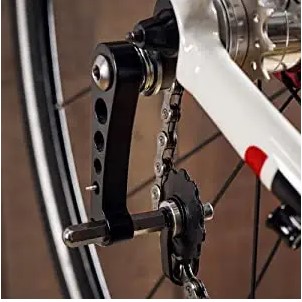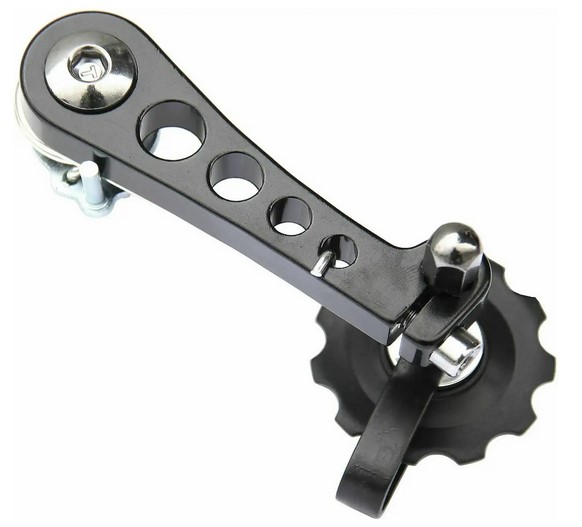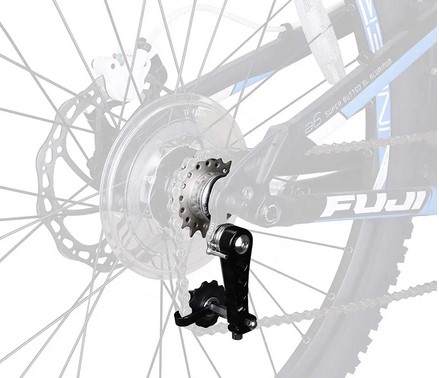If your bike chain sags excessively, it can create excessive noise and vibrations and hinder the chain from engaging the sprocket properly, thus compromising its functionality. However, don’t fret because a chain tensioner can help solve your problem, but first, are chain tensioner good?
Chain tensioners/ singulator are good because they adjust a chain’s slackness and relay drive torque evenly, allowing them to continue operating properly and engaging the sprocket well. They also keep the wheels on bicycles with frames that have vertical dropouts from moving around.
Singulators also extend your chain’s lifespan. Knowing when to use and when to forgo a chain tensioner is key to your bicycle operating correctly.
This post gives you information on the necessity, purpose, and installation process of a chain tensioner.

What Is A Chain Tensioner For? (Chain Tensioners Uses)
Before we dig deeper into the topic at hand, are chain tensioner good, it is vital to touch on the purpose of this component. Chain tensioners are designed to help maintain proper tension on a bike chain.
They get rid of chain slackness to ensure the chain and the bike stays operational continuously. This is necessary because slackness in a belt or chain can make these parts noisy and create vibrations.
In addition, slackness can hinder the bike chain from operating successfully and engaging with the sprocket properly. Besides that, a chain tensioner will help prolong your chain’s life, saving you money and time you’d have spent shopping for and installing a new chain frequently.
Chain tensioners have push-up or push-down springs, with the push-down version being more popular since it accommodates more bikes and drivetrains.
Types Of Chain Tensioners- Are Chain Tensioner Good?
Now that you know the importance of chain tensioners let’s look at the types at your disposal.
1. Fixed Chain Tensioners
These tensioners comprise a metal slotted frame that has a chain guide made of plastic and needs manual adjustment. You will require a single bolt to adjust the tension if you have fixed chain tensioners.
Fixed chain tensioners are ideal if you don’t need automatic tensioning. Additionally, they are suitable in drives with frequent speed changes and torque reversals.
Consider Origin8 Chain Tension Adjuster (Amazon link) if a fixed chain tensioner suits you. It’s compact, lightweight, equipped with Chromoly bolt, forged with alloy, and suits 3/8 axles.
2. Automatic Tensioners
These are made to offer constant, automatic chain or belt tension using built-in compression springs. You don’t need to make periodic manual adjustments with these tensioners.
They work for drives that function in any direction. Automatic tensioners are mounted on a bike chain’s unloaded strand with the springs compressed to absorb the slack.
The tensioning spring will extend, taking up the additional slackness as the chain experiences wear. This tensioner comes in two versions- linear tensioner and rotary tensioner.
A linear tensioner provides take up in a straight line for various drive mechanisms. It has two shafts that are spring-loaded attached to a plastic chain guide or a triangular mounting block.
On the other hand, a rotary tensioner gives tensioning action at full 90°. The tensioner’s body has compression springs that offer automatic take up.
Are Chain Tensioners Necessary?
Chain tensioners are necessary for bike frames with vertical dropouts as they are operating to prevent the wheel from moving back and forth. You cannot control the chain tension without a chain tensioner or derailleur.
On the contrary, chain tensioners aren’t necessary for frames with semi-horizontal or horizontal dropouts. This is because sliding back the rear wheel lets you develop chain tension in bicycle frames with horizontal dropouts, thus eliminating the need for a chain tensioner.
Horizontal dropouts come in semi-horizontal and track ends versions. You will typically see rear-facing or track-end dropouts on dirt jumpers, some MTBs, BMX, and track bikes.
- Track Dropouts
Track dropouts are convenient when converting a geared drivetrain to a single speed. Furthermore, they are safer, cheaper, and make chain singulators unnecessary.
However, you can utilize a chain tug if you have track dropouts despite not needing a chain tensioner. This will keep the rear wheel from going into the dropout and allow you to readjust the chain tension.
- Semi-Horizontal Dropouts
You will likely find these dropouts on old-school or vintage bicycles, mainly from the 70s and 60s. Frames with semi-horizontal dropouts are purposed for bicycles with rear derailleurs.
They are commonly used to convert a bicycle into single-speed because they make sliding back the axle much easier. Moreover, they remove the need for a chain tensioner when adjusting the chain tension.
They imitate the t-pulley system of a rear derailleur. However, semi-horizontal dropouts don’t work with chain tugs.
Do I Need A Chain Tensioner For A Single Speed?
Your single speed will require a chain tensioner to prevent wheel movements in a bicycle with a frame fitted with vertical dropouts. On the contrary, singulators are dispensable for horizontal dropouts.
Single-speed bikes don’t have handlebar shifters, derailleurs, and cables linked with them. The necessity of chain tensioners in single speeds stems from the rear derailleur absence, which leads to chain tension loss.
While you could employ half-chain links to revert a stretched chain to the correct tension, this s an inefficient and annoyingly slow process. Therefore, you are better off relying on a chain tensioner.
On the flip side, you won’t have to worry about changing gears when riding a single-speed bike; all you have to focus on is pedaling. Furthermore, it’s cheaper, allows long fenders, easy wheel removal, and the bike’s simplicity deters thieves.
If you are in the market for a chain tensioner for your single-speed bike, consider CyclingDeal Bike Single Speed Aluminum Chain Tensioner (Amazon link).
It’s made of an 11T plastic pulley, aluminum alloy, fits single speed chains of 1/8”, and is ideal for MTB and road bikes.

How To Install Chain Tensioner Single Speed?
The installation process of a chain tensioner on a single-speed will generally vary based on the singulator. However, here’s what to expect to do:
- Detach the axle nut situated on the drive-side.
- Put the chain tensioner against the rear dropout’s face.
- Put the axle nut back and tighten it.
- Loosen and pull back the rear wheel, then add tension to the bike chain
- Use the chain tensioner screw to adjust the tension while making sure the rear wheel is centered.
- Tighten the axle nut once again to ensure it’s properly secured.
Can You Use A Derailleur As A Chain Tensioner?
You can use an existing derailleur as a chain tensioner if you don’t want to spend money buying one or can’t afford it.
You can dumb down a derailleur into a singulator using only limit screws or combining limit screws with cable. The latter is a more sophisticated method and gives you finer adjustments, while the former is more straightforward.
Method 1: Limit Screws Only
- Disconnect and remove the shifting cable that goes to the rear derailleur.
- Align the rear cog with the pulley using the limit screws found on the rear derailleur. This will ensure your chain line is straight.
- Install the bike chain following the usual procedure. However, bring together both sides of the chain until you successfully position the t-pulley forward.
- Put a mark on the chain on that position and shorten it as desired. Add one or two links if you feel the tension will be excessive.
Method 2: Limit Screws And Cable
This method mostly resembles the first one. However, instead of cutting the cable going into the rear derailleur, cut it short.
Doing so will let you micro-adjust the pulleys’ position using the barrel adjuster at the derailleur’s back. Use the gear cable’s stopper as an anchor to ensure this works.
How Do You Make A Homemade Chain Tensioner? (A DIY Chain Tensioner)
You can put your hands and imagination to work and create a DIY chain tensioner if you’re feeling inspired. While this sounds exciting, note that you might not come up with a perfect product, but that shouldn’t worry your much.
Follow these fundamental steps to make a homemade chain tensioner.
- Get your tools- rear bicycle reflector, scissors, PVC hose (small garden), zip ties, and a Phillips head screwdriver.
- Take apart the bike reflector, then take out the nuts and bolts. It’s okay to throw away the reflecting piece; however, keep everything else because you’ll need to restore it.
- Put the garden hose onto the bike reflector’s round part. You can hold it under a tiny flame (be careful not to burn) or insert it into boiling water to ease the process.
- Attach your DIY chain tensioner, ensuring the chain goes through the circle. Reattach the bolt and nut and attach the second reflector piece if you wish. Doing so will let you fit the singulator more securely, but the bike chain won’t be pulled up that much.
- Zip tie the chain tensioner through the remaining reflector’s hole/holes then to the bike’s chainstay. Ensure you keep a balanced distance between the tensioner and the front chainrings.

FAQs
1. What Does A Single Speed Chain Tensioner Do?
A single-speed chain tensioner corrects and maintains a single-speed bicycle’s chain tension. This is essential because the absence of a rear derailleur on such bikes translates to a loss of chain tension.
2. What Is The Use Of Chain Tensioner?
A chain tensioner maintains chain tension by getting rid of chain slack hence keeping it working correctly. It also decreases sprocket, chain, and pulley wear, increasing the drive components’ life.
3. Do You Need A Chain Tensioner?
You need a chain tensioner if you have a bike whose frame has vertical dropouts to make sure the wheel doesn’t move back and forward. Additionally, it corrects and keeps the chain tension of your single-speed chain bicycle.
4. How Does A Chain Tensioner Work?
As mentioned earlier, chain tensioners have push-down or push-up springs. The pulley in the push-down spring is found inside the chain and operates by forcing the spring down.
On the other hand, the pulley in the push-up spring is beneath the bicycle chain and pushes the spring up.
5. Do Fixies Need Chain Tensioners?
Fixies frames that have horizontal dropouts usually need chain tensioners to screw the axles firmly and securely to the bike frame and fasten the back wheel properly. You can mechanically implement this chain tension-type quickly, and it permanently maintains the chain to the preferred length.
In Conclusion, Are Chain Tensioner Good?
Chain tensioners clearly serve a vital purpose for ensuring your chain maintains optimum tension and your bike functions properly. Just confirm when and how to utilize it to enjoy its benefits fully, which includes keeping you safe when pedaling hard.
Also, read:
